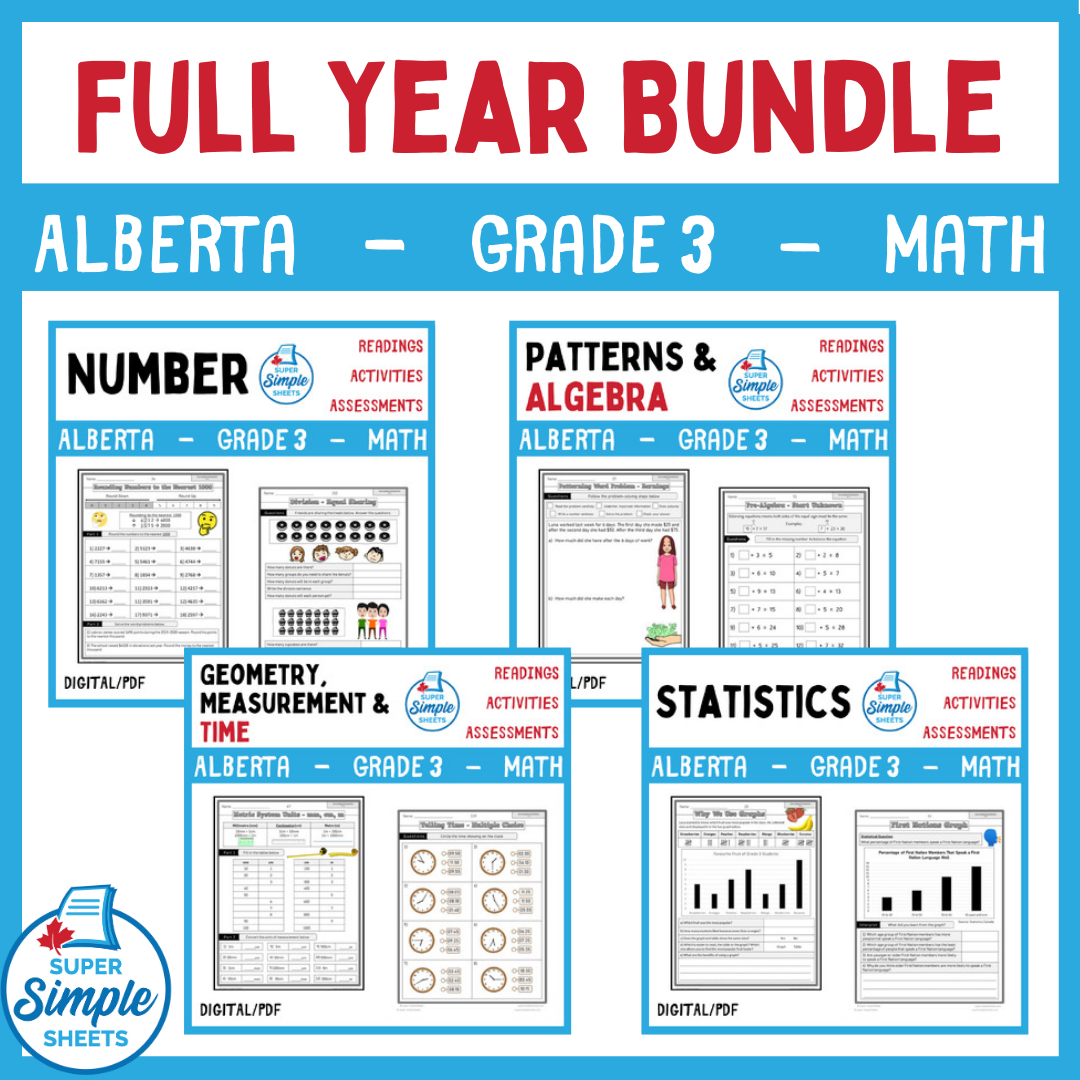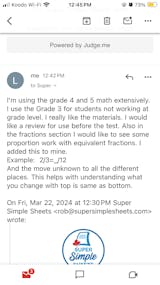Grade 3 - Alberta Math - Full Year Bundle NEW 2022 Curriculum
Grade 3 - Alberta Math - Full Year Bundle NEW 2022 Curriculum
Interested in a bundle? Shop below instead!
Couldn't load pickup availability
PRODUCT PREVIEW
FULLY UPDATED FOR THE NEW 2022 CURRICULUM! PDF AND GOOGLE SLIDES INCLUDED!
Grade 3 - NEW 2022 Alberta Math Curriculum – This resource covers all outcomes in the Grade 3 - Alberta Math Curriculum. NO PREP - JUST PRINT! Perfect for distance teaching, simply send students a PDF copy of the worksheet.
Check out each of the strands below to learn more about the resources included in this bundle.
Strand 1 - Number (Number Sense)
Concepts that are covered:
- Place value of numbers within 100 000
- Determining the value of digits within 100 000
- Expressing natural numbers using words and numerals
- Rounding natural numbers to various places (10, 100, 1000)
- Compare and order natural numbers within 100 000
- Money – counting and representing values using cents and dollars
- Loonies, toonies, and bills as dollars
- Recognize French and English symbolic representations of monetary values
- Adding and subtracting of two-digit numbers
- Using standard algorithms to add and subtract
- Estimate sums and differences – rounding and front-end estimation
- Solving word problems involving addition and subtraction
- Multiplication and division facts
- Representing multiplication and division using models and arrays
- Multiplication mental math strategies – skip counting (repeated addition), doubling and halving
- Division mental math strategies – repeated subtraction, skip counting
- Writing multiplication and division sentences to represent problems
- Determining the missing quantity in a product or quotient
- Examine patterns in multiplication and division – skip counting and multiplication table
- Model fractions limited to denominators of 12 or less
- Name fractions
- Benchmark fractions
- Comparing the size of fractions – common denominators, common numerators
- Writing fractions on a number line
- 4 Unit tests
- Answer pages for all activities
Strand 2 - Patterns and Algebra
Some of the concepts that are covered:
- Number patterns
- Increasing and decreasing number patterns
- Finding number patterns using a hundreds chart
- Odd and even number patterns
- Ordinal numbers
- Finite and infinite sequences
- Skip counting – rows and columns of a multiplication table
- Finding the missing term in a skip-counting sequence using multiplication
- Describing the change from term to term – pattern rules
- Writing equations that represent a simple problem
- Balancing an equation
- Writing two expressions that equal each other
- Modelling equations using a balance
- Finding an unknown number in an equation
- Determining the unknown number in an addition, subtraction, multiplication and division sentence
- Solving word problems involving unknown numbers and all four operations
- 2 Unit Tests
- Answer pages for all activities
Strand 3 - Geometry, Measurement and Time
Some of the concepts that are covered:
- What is a polygon?
- Perpendicular and parallel sides
- 90° angles
- Finding 90° angles in your environment using referents
- Regular vs irregular polygons
- Triangles, quadrilaterals, pentagons, hexagons and octagons
- Classifying polygons based on number of sides and angles
- Transformations – translations, reflections, rotations
- Describing transformations
- Performing transformations
- Comparing millimetres, centimetres, and metres
- Justify the choice of millimetres, centimetres, or metres to measure
- Measure lengths of straight lines and curves, with millimetres, centimetres, or metres
- Imperial system – inches, feet, and yards
- Relating metric units to imperial units – cm to inches, cm to feet, metres to yards
- Finding the perimeter of polygons
- Determining the unknown length of polygons using the perimeter
- Estimate lengths using centimetres and metres using referents
- Comparing angles using superimposing methods
- Comparing two angles using a referent
- Investigate relationships between seconds, minutes, and hours using an analog clock
- Relate minutes past the hour to minutes until the next hour.
- Describe time of day as a.m. or p.m. relative to 12-hour cycles of day and night.
- Tell time using analog and digital clocks.
- Express time of day in relation to one 24-hour cycle.
- 3 Unit Tests
- Answer pages for all activities
Strand 4 - Statistics and Probability (Data Analysis)
Some of the concepts that are covered:
- What is a statistical question?
- Create statistical questions to investigate
- What is a population?
- Predict the answers to statistical questions
- First-hand data and second-hand data
- Collect first-hand data
- Tally marks and frequency tables
- Create statistical questions for second-hand data
- Represent first-hand data in a dot plot
- Represent first-hand data in a bar graph
- Represent second-hand data in a bar graph
- Interpret dot plots and tell the story of the data
- Interpret bar graphs and tell the story of the data
- Interpret bar graphs of First Nation and Inuit topics
- Unit test
- Answer pages for all activities
This is a comprehensive unit that will save you hours of planning! It has been tested and found effective in helping students achieve the specific learning outcomes created by Alberta Education.
Share

Units are broken down into very manageable parts. There are options for hands-on activities as well as paper/pencil practice. I love the exit slips that are included after each portion of an outcome. There is more here than you need - which is helpful for students who may need extra practice and could use additional questions/activities in addition to classroom lessons.
These sheets are great. Gives my son extra practice.





